5 top garden design tips – and how to avoid two common mistakes!
I’ve been picking up top garden design tips from the award-winning Charlotte Rowe Garden Design consultancy.
Charlotte Rowe and her Design Director Tomoko Kawauchi believe that ‘function comes first’ when designing a garden. They cite three factors that influence the design of a garden. They are the taste and style of the owner, the interior or architecture of the house and the ‘structure’ of the garden.
The structure is essentially the hard landscaping. That’s the most expensive part of the garden and also the most difficult to change. So it’s important to get it right.
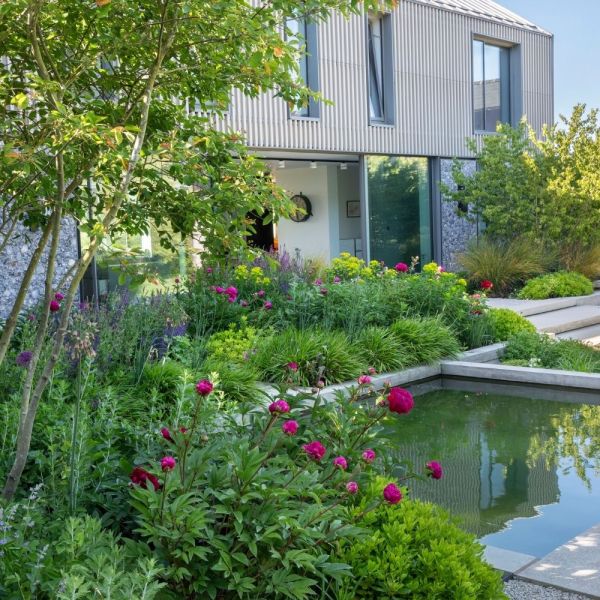
Two gardens by Charlotte Rowe Garden Design were short-listed for the 2021 Society of Garden Designers People’s Choice award. Photograph by Marianne Majerus.
You can see the video interview with Charlotte and Tomoko, plus more views of Charlotte’s own garden and some other ‘before’ and ‘after’ shots here.
Garden design tip 1: Put function and structure first
‘When a garden owner thinks about designing their garden, they often think about with what plants they want or what furniture they like,’ says Tomoko. ‘But a garden designer sees the garden on a bigger scale. We see it as a whole. So we start with the architecture, with what’s already on site and your lifestyle. And we think about the services (eg electricity and water) and the materials for hard landscaping.’
And Charlotte explains that when they first meet a client, they go through what they want from their garden and what they want to do there.
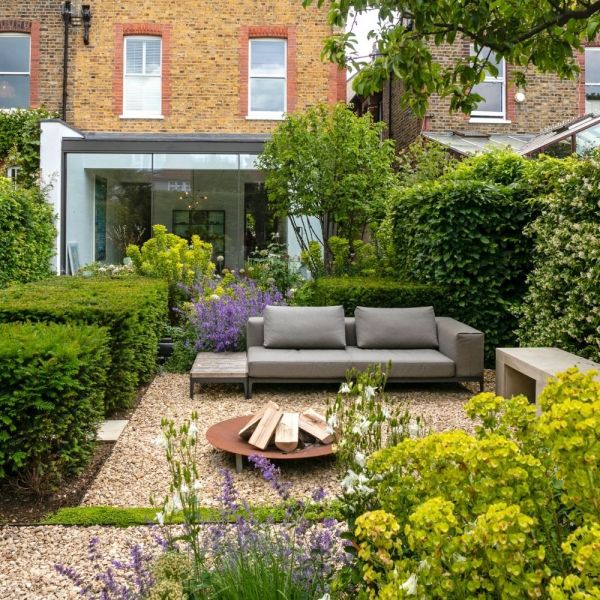
One of the best garden design tips is to place your seating area where the light or the view is best. It doesn’t always have to be directly outside the back of the house! Designed by Charlotte Rowe Garden Design, this ‘Barnes Garden’ was also short-listed in the SGD Awards. Photograph by James Kerr.
This is the important difference between a professional designer and an amateur like me. When designing a home or garden, a designer starts with ‘what do you want to use this room or garden for?’ Whereas the amateur will start with ‘where shall I put this?’ or ‘what goes here?’
It’s a fundamental shift to the way you think. We all have a fixed idea or ideas about our home or garden to some extent. So that anchors us to a preconceived notion of what goes where.
For example, you already may have a set of garden furniture. Maybe you don’t want to change it. But if you start your garden design with ‘where do I put the furniture?’ then you may forget about other aspects, such as where the sun falls or where the view is best.
There are more garden seating ideas here.
Make a rough ‘bubble’ plan
Many designers do ‘bubble plans’ says Charlotte.
List what you want to do in your garden – somewhere to perch for a morning coffee, children’s play area, practical and storage areas, veg growing or flower borders, where you’d like to eat or entertain…
Then list what you’d like to see. For example, what is the view from the house? Would you have a more attractive view if you placed the main eating terrace at the end of the garden? Or in the middle of the garden?
Then make a rough map of your garden showing these areas. You need the training to draw up a proper garden design plan, but working different areas out roughly on a ‘bubble’ plan will help free you of restrictions. If you try to change things just by looking at the garden itself, it may not be possible to imagine the terrace – for example – being in a different place.
But on a plan, you can move anything around. Charlotte often places the dining terrace at the other end of the garden, creating a ‘destination’ in the garden. And when you are eating at the end of the garden, you are immersed in the garden. It’s a different world.
Tip 2 – think laterally
Many of the gardens designed by Charlotte and Tomoko are in awkward spaces. Or they’re small city gardens, long thin gardens or wide gardens.
‘Larger gardens are easier for the amateur to design themselves,’ says Charlotte. That’s because there’s a high proportion of planting. And planting is the easiest element to change if you don’t like what you’ve done.
But if you have a small or awkwardly shaped garden, then one of Charlotte’s best garden design tips is to go across the garden. She often uses lateral elements to break up the design. ‘It fools the eye,’ she says.
That means running borders, terraces, low hedges, paving or even ponds laterally across the garden. Instead of the traditional border or hedge running down the sides of the garden to the end, you go from side to side.
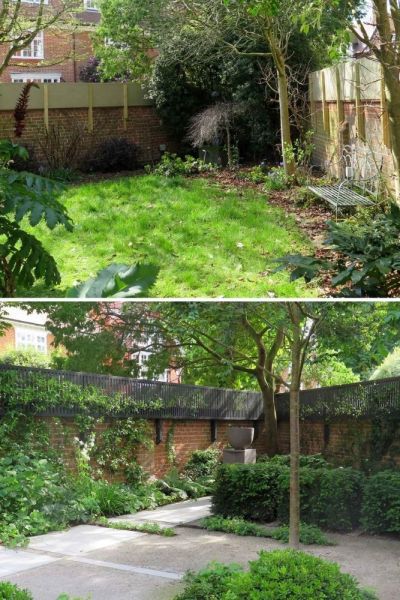
A before (top) and after (above) of a garden in Chiswick, designed by Charlotte Rowe Garden Design. It’s an awkward wedge shaped space but that is disguised by running paving, low hedging and small rills of planting across it. Note how painting the trellis black makes it ‘disappear’.
‘You’re playing with perspective,’ explains Charlotte. That’s because the eye stops at each element crossing the garden. If you plant borders down the sides, with a lawn in the middle, the eye goes straight to the end of the garden.
So planting across the garden – laterally – means it takes people longer to see the whole garden. And that helps make it feel larger than it is.
This tip works equally well with awkward shapes, long thin gardens or even wide gardens (here’s a wide shallow garden transformation). There are more ideas for narrow gardens here in 8 steps to the long thin garden of your dreams.
Tip 3 – dark fencing, walls or trellis
‘Dark colours recede,’ says Charlotte. And light colours, like white, make surfaces look closer. So Charlotte often uses very dark grey or other almost-black colours to make fences, trellis and walls seem less obvious.
‘In a small garden, a white wall or pale fence can make you feel more closed in,’ says Charlotte. And very dark shades make a wonderful background colour for planting.
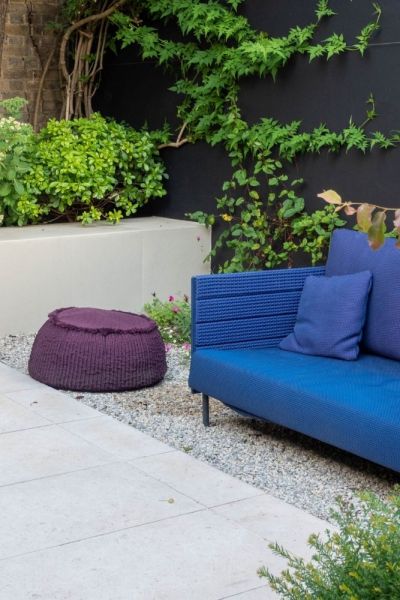
In Charlotte’s own garden a ‘very dark grey’ wall makes one side of the garden recede into the background and it’s a wonderful foil for green foliage.
If you don’t have the budget for a full garden re-design, Charlotte recommends painting your fences dark. It’s an instant and relatively cheap way to smarten up the look.
There are more tips for saving money on garden design here.
Garden design tip 4 – plant near the house
‘Planting near the house helps to bring the garden into the house’, explains Charlotte. It also makes the eye stop. So first, you enjoy the planting. Then you look further out to see what is beyond. It’s part of playing with perspective.
Charlotte’s own garden is a small courtyard garden. So she has two lateral borders, which she calls ‘promontories’ just outside the big glass doors at the back.
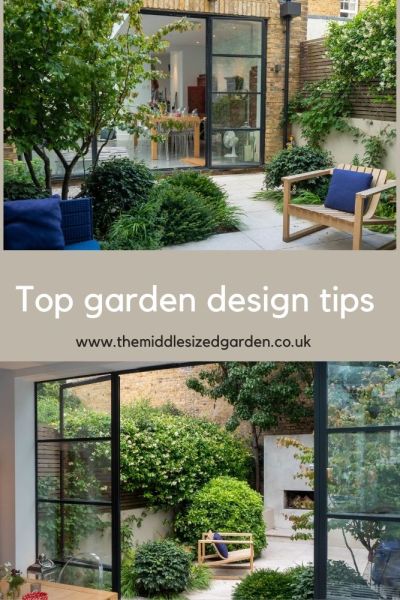
Charlotte’s garden from the house and looking back at the house. There is a large and a small lateral planting bed just outside the back of the house. The gap between them invites you to step out and explore the garden.
Tip 5 – plant evergreens in a small courtyard garden
If you have a small courtyard garden Tomoko advises you to major on evergreen planting. A herbaceous border full of flowers may be empty for half the year. In a large garden it’s easier because you can have different areas looking good at different times. There will be distractions when the herbaceous border is empty.
Charlotte’s own garden demonstrates this beautifully.
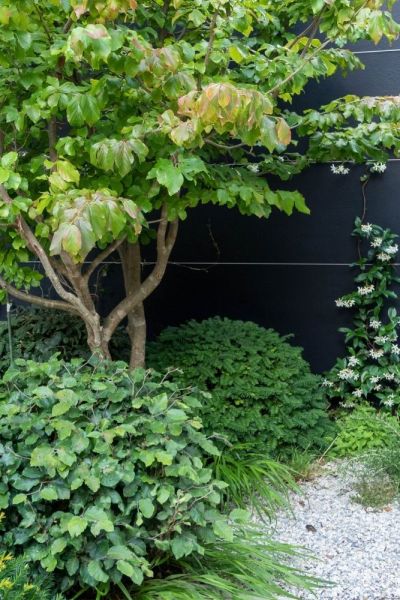
Planting close to the house in Charlotte’s garden. I love the texture and shape created by the two balls. One is beech and the other yew. Beech leaves die in winter, but they stay on the plant so this will create a lovely play of texture and colour. The grasses too will change colour.
If you love having seasonal flower colour, you can always achieve it through pots and containers.
Garden design tips – what to avoid!
Sometimes the best garden design tips aren’t about what you should do, but what you shouldn’t do.
Garden design mistake 1
‘Don’t automatically “centre” the garden,’ advises Charlotte. ‘It’s the most common mistake I see. Many houses, especially in UK towns and cities, don’t have centred architecture. They’re often terraced or semi-detached houses, with a door on one side.’
I sometimes get queries from people who have modern houses, which they feel lack character. ‘I don’t feel my house has an architecture,’ said one reader. ‘So I don’t know how to echo or mirror it with my garden design.’
Whether you feel your house is a designer special, a historic home or ‘just a house’, think about where the doors and windows are. Line the focal points and paths up with front and back doors or views from windows.
Charlotte’s own house is a London terrace, with a front door to the left. So when she designed her garden, the focal point is to the left, lined up with the front door.
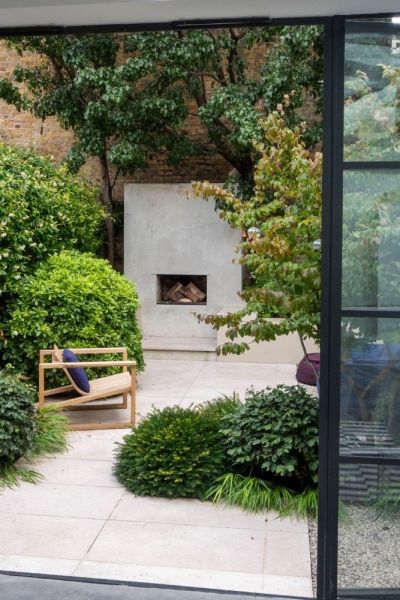
Charlotte’s outdoor fireplace is the focal point of her garden. It’s on the left, to echo the position of her front door.
If you’re using paths as part of the hard landscaping, find out what you need to know about garden paths here.
And mistake 2 – don’t make the borders too small!
Charlotte says that this is the most common mistake made by people who design their own gardens. Plants need space to grow properly. One big border will always look better than two small ones.
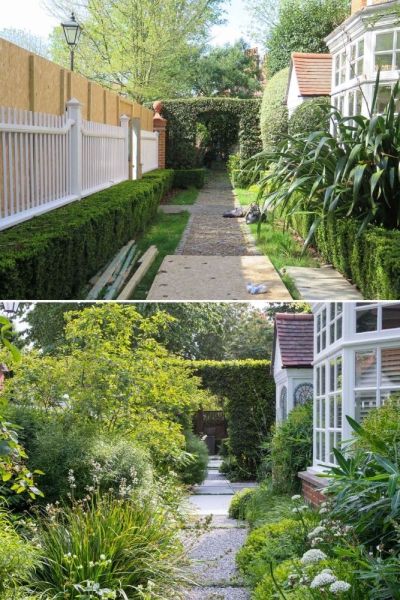
A before (top) and after (above) front garden of a house in Chiswick, designed by Charlotte Rowe Garden Design. The full borders and lush planting of the lower photograph make the house feel more welcoming. It even seems bigger, somehow! This is a narrow space but trying to keep it neat and controlled made it seem smaller.
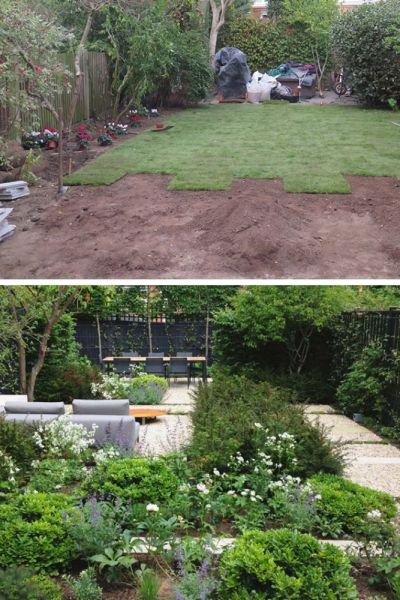
This is a before (top) and after (above) of the garden in Barnes, which is short-listed for the SGD People’s Choice award. A dining terrace at the end of the garden creates a destination. Big blocks of planting add colour. And a central seating area is perfectly positioned to enjoy the evening sun. The near-black fencing ‘disappears’ into the greenery.
More useful information on garden design
Having a theme for your garden style can help you make up your mind about what to buy and choose, so check out 12 garden styles here. And if you want to save money on garden design, this post has tips from a variety of experts.
To find a qualified garden designer, then see the Society of Garden Designers here. Figures vary but research has suggested that a properly designed and landscaped garden could add between 5% and 15% to the value of your home. So that can give you a budget to aim for.
Many people ask how much it costs to have your garden professionally designed and landscaped. There are so many factors – access, whether your land is sloping, what has to be cleared away, what kind of materials you use and more. But it’s generally considered that even a very small garden will cost at least £20,000 for a complete re-design, including fees, planting and all the hard landscaping.
For more about the basics of garden design, see these tips on how to design your garden from Polly of Pollyanna Wilkinson Garden Design. And there are more garden design tips from experts here.
You could also consider a one-day course on garden design, like this one run by KLC. You can’t become garden designer in a day or from reading a few blog posts. But it can help you get the best possible result and avoid expensive mistakes.
What’s the difference between garden designers and landscapers?
Garden designers create the design, draw out plans, measure out the site and usually specify materials.
Landscape companies follow the designer’s plan. They do the heavy work, digging paths, building walls, laying pavers and putting up trellis. Some companies do both, but don’t automatically expect a landscape company to be designers as well.
Here are the 12 professional insider tips for landscaping your garden.
What about using an architect or builder to landscape your garden?
If you’re having your house re-modelled, many garden designers say ‘don’t automatically use the same team in the garden.’
For example, garden steps need to be built to different proportions to house steps.
Are larger gardens different?
Top garden designers like Charlotte and Tomoko design both large and smaller gardens. And the principles are very much the same.
A larger garden is often divided up into ‘garden rooms’, each of which may have a different theme or function. It is important, however, to have some overall vision or design to draw the different areas together. That can be a garden designer or an owner or head gardener with a strong vision for it.
Find out what you need to remember when renovating a larger garden here.
Good books on garden design
Charlotte Rowe Garden Designs have also featured in a number of books on garden design, which you may find helpful in planning your own garden or choosing a designer. They include Garden Design Masterclass, Garden Design – a Book Of Ideas by Heidi Howcroft and Marianne Majerus and The RHS Design Outdoors. Also The RHS Encyclopedia of Garden Design.
Note that links to Amazon are affiliate, which means I may get a small fee if you buy, but it won’t affect the price you pay.
And don’t miss Charlotte’s 12 Creative tips for a stunning urban garden here.
Pin to remember garden design tips
And do join us for a free weekly email with tips, ideas and inspiration for your garden. Find out more here.
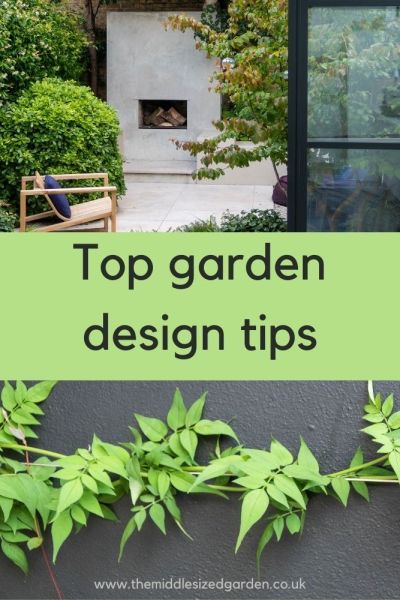
























Thank you for this comprehensive article! I also watched your video on this which was fabulous! You wouldn’t by any chance know the name of the tree Charlotte Rowe has planted just outside her back door close to the house? It has wonderful leaves and structure! Thank you
I believe it’s Parrotia Persica, otherwise known as the Ironwood Tree.
This is SUCH a helpful post, love all the tips & ideas – thank you so much!
Thank you!
Not a comment on the above post, but a question.
Have you done anything about decorating with mirrors in the garden?
I’m very intrigued, but wonder about how safe, etc.
Curious for your ideas!
There’s quite a lot of debate about the use of mirrors in gardens. This is because of the risk of birds seeing the landscape reflected in the mirror without realising that it’s only a reflection. The RSPB advises against putting mirrors in gardens, saying that they have known of many instances where birds have flown into mirrors or into windows when they reflect like mirrors. There was a small mirror in the corner of a pergola in this garden when we moved in and a blackbird used to spend all day pecking at its ‘rival’ in the mirror. The RSPB do say that you can put something like a sticker on the mirror and the bird will realise it’s a hard surface, so perhaps mirrors can be done, but I haven’t done one. It’s probably safe to have a very small mirror, because birds would be unlikely to fly directly through what they might see as a small aperture without checking it all out first. I hope that helps.
Ideas to Redesign an existing overgrown Japanese gard3n
Interesting!